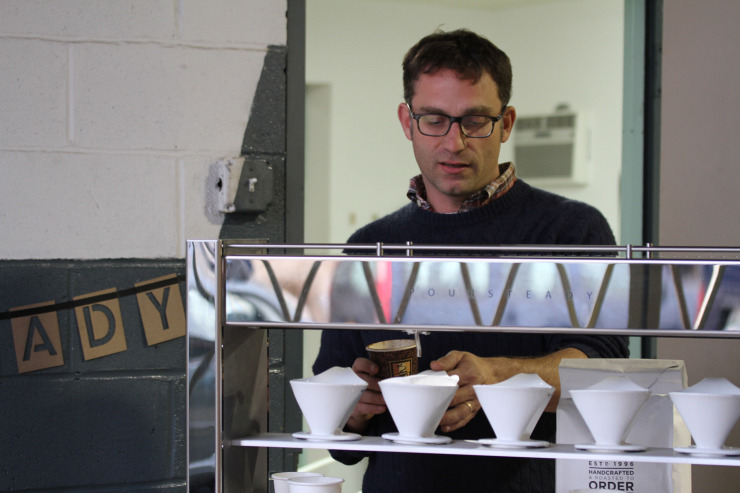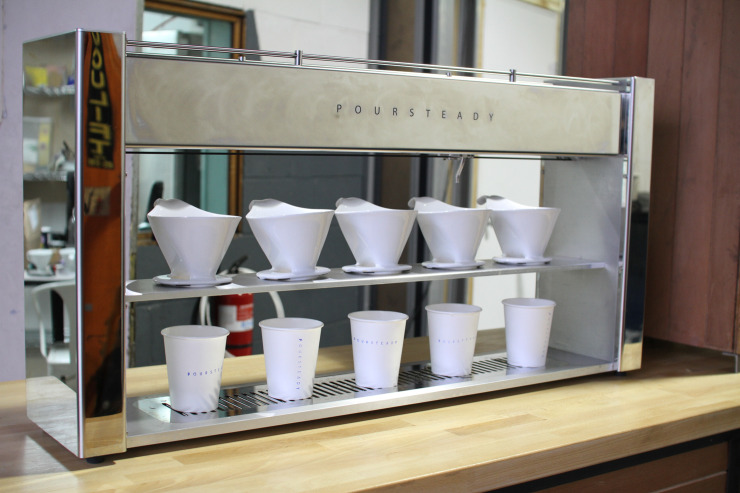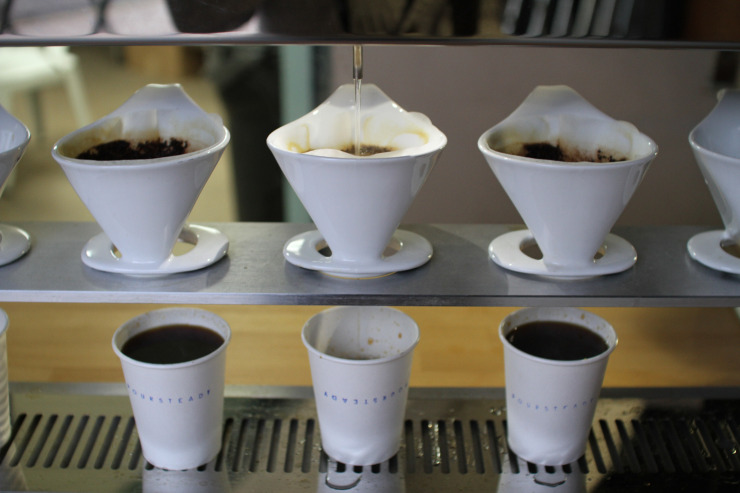
What cafe owner hasn’t dreamed of a magical way to streamline and perfect the by-the-cup brewing process, in a way that ensures repeatability, diminishes strain on repetitive motion from the barista, and frees up skilled front-line staff to refine even more of their talents? We’re certain nearly every one of them has—but surely no one would predict a team of NASA-caliber engineers working out of an industrial Brooklyn garage would want that just as badly. Enter Poursteady, a maker startup hoping to bring delicious, reliably brewed robot-assisted coffee to a cafe near you. To find out more, we met with the team at their offices in Gowanus, Brooklyn.
The machine isn’t a brewer per se, but rather a hi-tech water delivery device that can be programmed to pour water into up to five manual coffee dripper cones of the barista’s choice at once, eliminating the most difficult steps of the pour-over process. It doesn’t replace a barista—a point the four-person Poursteady team is careful to stress—cafe staff will still dial in dose and grind and baristas will have the ability to program in precise water-pouring patterns themselves. Baristas will grind, dose and deliver the coffee to Poursteady’s brewing station, where pre-heated water will perform a series of pouring stages while the barista is free to discuss the coffee with you in-depth, or prepare further cups.

The machine’s genesis came from its engineers’ innate drive for efficiency. “We came up with the idea a few years ago watching the baristas at fancy pants San Francisco coffee shops,” said Mark Sibenac, Poursteady’s lead electrical engineer, who along with mechanical engineer Stuart Heys, has years of experience in providing automation technology in the form of robots for NASA, the US Navy, and other Government agencies. Sibenac realized he and Heys—having already outfitted robots for Mars expeditions— certainly possessed the ability and resources to pour water into coffee filter cones automatically. “We collect a lot of industrial automation parts off of eBay,” said Sibenac, “and Stuart has a machine shop, so…”
“We were able to make the first prototype for almost nothing,” said Heys. “This is the kind of stuff we do every day anyway.”
Working out of a Gowanus workspace shared with another tech startup, the ReFactory, Sibenac, Heys, and Poursteady’s other two founders, Stephan von Muehlen (CEO) and Greg Mihalko (design), produced a prototype of the pour-over robot that’s already being greeted with acclaim. At its public debut at the Maker Faire in 2013, the machine garnered five blue ribbons; this past weekend at Engadget‘s Expand NY exposition, it took Judge’s Choice in the Insert Coin competition for inventor startups. In what will come as a surprise to no one, the founders recently launched a Kickstarter campaign to realize their initial production dreams.
But while the maker/tech startup community has already taken a keen interest in Poursteady, the device is still relatively unknown in specialty coffee circles. In part, it’s because the device is intended for commercial use—a much more niche angle of approach than the myriad home-brewing-devices on Kickstarter, and perhaps coming in the wake of Clover, Steampunk, Blossom, and BKON-fatigue: other by-the-cup predecessors with high price tags and geeky pedigrees. But where those brewers lead with their bells and whistles, Poursteady–which is not even technically a brewer–is a subtle presence. It’s a gleaming pour-over cabinet (the team plans to build subsequent Poursteady units in a more matte finish) whose talents lie largely beneath the surface.

Currently, the cup profile is determined through an app that communicates with Poursteady. For all five stations, the barista currently sets a single profile. “Going forward, in real retail environments, the next fun part is going to be making the interface so you can start to have the same kind of throughput and efficiency but have different profiles for different beans or different sizes,” says Sibenac.
The barista can initiate a cup of coffee from any station, even while a brew is already in progress, and the electronics will figure out how to schedule each dispensation of water, from filter rinse to initial bloom through to multiple pouring phases.
“On the tech app side, you can set the time of bloom to how big the spiral should be, how many pours, even what kind of pattern. We can do zig-zags, or nice spirals spinning outward from the center. Every barista wants to control it his or her own way and make it theirs,” continued Sibenac. The robot works on both an X-axis, to visit all pour stations, and a tilt axis, to deliver the preprogrammed pouring pattern. It’s usable with the filter cone of your choosing—and the development team hopes to learn from baristas using Poursteady in the field how they want it to perform dripper to dripper.
“We’re interested to see what coffee shops want to use, for instance the Beehouse where it drips through really slowly, or a Hario v60 where it pours through really fast,” said Sibenac.
The machine is network-ready, currently operating over Wifi with Bluetooth technology planned for the future. The team sees potential to deliver not only post-brew data like analytics and statistics, but pre-brew integration with technologies like Square Pickup and other I’m-almost-there ordering technologies.
Though the team initially employed an external hot water heater, it became clear that the real estate required was too big, and that—hey, why not?—the team may as well build their own hot water heater. It’s now located under-counter, utilizing a low-pressure-fed flow system with closed-loop controller to keep the water in the tank regulated. App integration with the custom water heater is forthcoming.

Ultimately, Heys points to throughput, consistency and reliability as the engineers’ key goals with Poursteady.
“We do field robotics,” Heys says. “A robot we built for NASA just came back from the Mojave Desert after two weeks, so we’re used to having everything have to work perfectly all the time. If these are going to be in shops—you can base a whole shop around one machine—it can’t break. It’s such a huge deal. I know the experience of having your machine break out in the field. It’s awful.”
And as for reliably delicious coffee, Heys gives credit where it’s due.
“We rely on the barista for that, and the roaster.”
Poursteady plans a mid-2015 product rollout, with initial pricing in the $15,000 range. Visit their website here and their Kickstarter campaign here.
Liz Clayton is the Associate Editor at Sprudge.com, and helms our NYC desk. Read more Liz Clayton on Sprudge.
All photos by Liz Clayton for Sprudge.com

